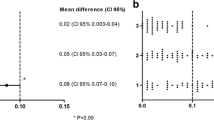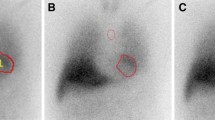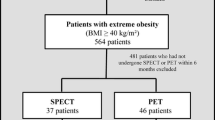Abstract
Background
The relationship between general obesity or abdominal obesity (abdominal circumference of ≥85 cm in men and ≥ 90 cm in women) and the heart-to-mediastinum ratio (HMR), a measure of cardiac sympathetic innervation, on cardiac iodine-123-metaiodobenzylguanidine scintigraphy (MIBG) in patients with heart failure with preserved ejection fraction (HFpEF) has not been clarified.
Methods
A total of 239 HFpEF patients with both MIBG and abdominal circumference data were examined. We divided these patients into those with abdominal obesity and those without it. In the cardiac MIBG study, early phase image was acquired 15–20 min after injection, and late phase image was acquired 3 h after the early phase. A HMR obtained from a low-energy type collimator was converted to that obtained by a medium-energy type collimator.
Results
Early and late HMRs were significantly lower in those with abdominal obesity, although washout rates were not significantly different. The incidence of patients with early and late HMRs <2.2 was significantly higher in those with abdominal obesity. Multivariate linear regression analysis revealed that abdominal obesity was independently associated with early HMR (standardized β = −0.253, P = 0.003) and late HMR (standardized β = −0.222, P = 0.010). Multivariate logistic regression analysis revealed that abdominal obesity was independently associated with early (odds ratio [OR] [95% confidence interval {CI}] = 4.25 [2.13, 8.47], P < 0.001) and late HMR < 2.2 (OR [95% CI] = 2.06 [1.11, 3.83], P = 0.022). Elevated BMI was not significantly associated with low early and late HMR. The presence of abdominal obesity was significantly associated with low early and late HMR even in patients without elevated BMI values.
Conclusion
Abdominal obesity, but not general obesity, in HFpEF patients was independently associated with low HMR, suggesting that visceral fat may contribute to decreased cardiac sympathetic activity in patients with HFpEF.
Trial registration
UMIN000021831.





Similar content being viewed by others
Data availability
Not applicable.
References
Owan TE, Hodge DO, Herges RM, Jacobsen SJ, Roger VL, Redfield MM. Trends in prevalence and outcome of heart failure with preserved ejection fraction. N Engl J Med. 2006;355:251–9.
Steinberg BA, Zhao X, Heidenreich PA, Peterson ED, Bhatt DL, Cannon CP, et al. Trends in patients hospitalized with heart failure and preserved left ventricular ejection fraction: prevalence, therapies, and outcomes. Circulation. 2012;126:65–75.
Meta-analysis Global Group in Chronic Heart Failure (MAGGIC). The survival of patients with heart failure with preserved or reduced left ventricular ejection fraction: an individual patient data meta-analysis. Eur Heart J. 2012;33:1750–7.
Haass M, Kitzman DW, Anand IS, Miller A, Zile MR, Massie BM, et al. Body mass index and adverse cardiovascular outcomes in heart failure patients with preserved ejection fraction: results from the Irbesartan in Heart Failure with Preserved Ejection Fraction (I-PRESERVE) trial. Circ Heart Fail. 2011;4:324–31.
Tsuchihashi-Makaya M, Hamaguchi S, Kinugawa S, Yokota T, Goto D, Yokoshiki H, et al. Characteristics and outcomes of hospitalized patients with heart failure and reduced vs preserved ejection fraction. Report from the Japanese Cardiac Registry of Heart Failure in Cardiology (JCARE-CARD). Circ J. 2009;73:1893–900.
Nagai T, Yoshikawa T, Saito Y, Takeishi Y, Yamamoto K, Ogawa H, et al. Clinical characteristics, management, and outcomes of Japanese patients hospitalized for heart failure with preserved ejection fraction—a report from the Japanese Heart Failure Syndrome With Preserved Ejection Fraction (JASPER) Registry. Circ J. 2018;82:1534–45.
Tanaka S, Horimai C, Katsukawa F. Ethnic differences in abdominal visceral fat accumulation between Japanese, African-Americans, and Caucasians: a meta-analysis. Acta Diabetol. 2003;40:S302–4.
National Health and Nutrition Survey 2018, Health Japan 21. Available from: https://www.nibiohn.go.jp/eiken/kenkounippon21/en/eiyouchousa/kekka_shintai_chousa_nendo.html. Accessed 14 Aug 2020.
Tsujimoto T, Kajio H. Abdominal obesity is associated with an increased risk of all-cause mortality in patients with HFpEF. J Am Coll Cardiol. 2017;70:2739–49.
Verberne HJ, Brewster LM, Somsen GA, van Eck-Smit BL. Prognostic value of myocardial 123I-metaiodobenzylguanidine (MIBG) parameters in patients with heart failure: a systematic review. Eur Heart J. 2008;29:1147–59.
Agostini D, Verberne HJ, Burchert W, Knuuti J, Povinec P, Sambuceti G, et al. I-123-mIBG myocardial imaging for assessment of risk for a major cardiac event in heart failure patients: insights from a retrospective European multicenter study. Eur J Nucl Med Mol Imaging. 2008;35:535–46.
Alvarez GE, Ballard TP, Beske SD, Davy KP. Subcutaneous obesity is not associated with sympathetic neural activation. Am J Physiol Heart Circ Physiol. 2004;287:H414–8.
Jacobson AF, Senior R, Cerqueira MD, Wong ND, Thomas GS, Lopez VA, et al. Myocardial iodine-123 meta-iodobenzylguanidine imaging and cardiac events in heart failure. Results of the prospective ADMIRE-HF (AdreView Myocardial Imaging for Risk Evaluation in Heart Failure) study. J Am Coll Cardiol. 2010;55:2212–21.
Nakata T, Nakajima K, Yamashina S, Yamada T, Momose M, Kasama S, et al. A pooled analysis of multicenter cohort studies of (123)I-MIBG imaging of sympathetic innervation for assessment of long-term prognosis in heart failure. JACC Cardiovasc Imaging. 2013;6:772–84.
Parker MW, Sood N, Ahlberg AW, Jacobson AF, Heller GV, Lundbye JB. Relationship between quantitative cardiac neuronal imaging with 123I-meta-iodobenzylguanidine and hospitalization in patients with heart failure. Eur J Nucl Med Mol Imaging. 2014;41:1666–72.
Seo M, Yamada T, Tamaki S, Watanabe T, Morita T, Furukawa Y, et al. Prognostic significance of cardiac I-123-metaiodobenzylguanidine imaging in patients with reduced, mid-range, and preserved left ventricular ejection fraction admitted for acute decompensated heart failure: a prospective study in Osaka Prefectural Acute Heart Failure Registry (OPAR). Eur Heart J Cardiovasc Imaging. 2020:jeaa025.
Komici K, Bencivenga L, Paolillo S, Gargiulo P, Formisano R, Assante R, et al. Impact of body mass index on cardiac adrenergic derangement in heart failure patients: a 123 I-MIBG imaging study. Eur J Nucl Med Mol Imaging. 2020;47:1713–21.
Suna S, Hikoso S, Yamada T, Uematsu M, Yasumura Y, Nakagawa A, et al. Study protocol for the PURSUIT-HFpEF study: a prospective, multicenter, observational study of patients with heart failure with preserved ejection fraction. BMJ Open. 2020;10:e038294.
Alberti KG, Zimmet P, Shaw J, IDF Epidemiology Task Force Consensus Group. The metabolic syndrome—a new worldwide definition. Lancet. 2005;366:1059–62.
Tamaki S, Yamada T, Okuyama Y, Morita T, Sanada S, Tsukamoto Y, et al. Cardiac iodine-123 metaiodobenzylguanidine imaging predicts sudden cardiac death independently of left ventricular ejection fraction in patients with chronic heart failure and left ventricular systolic dysfunction: results from a comparative study with signal-averaged electrocardiogram, heart rate variability, and QT dispersion. J Am Coll Cardiol. 2009;53:426–35.
Masuda M, Yamada T, Mizuno H, Minamiguchi H, Konishi S, Ohtani T, et al. Impact of atrial fibrillation ablation on cardiac sympathetic nervous system in patients with and without heart failure. Int J Cardiol. 2015;199:65–70.
Okuda K, Nakajima K, Hosoya T, Ishikawa T, Konishi T, Matsubara K, et al. Semi-automated algorithm for calculating heart-to-mediastinum ratio in cardiac Iodine-123 MIBG imaging. J Nucl Cardiol. 2011;18:82–9.
Nakajima K, Okuda K, Yoshimura M, Matsuo S, Wakabayashi H, Imanishi Y, et al. Multicenter cross-calibration of I-123 metaiodobenzylguanidine heart-to-mediastinum ratios to overcome camera-collimator variations. J Nucl Cardiol. 2014;21:970–8.
Bemelmans RH, van der Graaf Y, Nathoe HM, Wassink AM, Vernooij JW, Spiering W, et al. Increased visceral adipose tissue is associated with increased resting heart rate in patients with manifest vascular disease. Obesity. 2012;20:834–41.
Nakajima K, Matsumoto N, Kasai T, Matsuo S, Kiso K, Okuda K. Normal values and standardization of parameters in nuclear cardiology: Japanese Society of Nuclear Medicine working group database. Ann Nucl Med. 2016;30:188–99.
Kline RC, Swanson DP, Wieland DM, Thrall JH, Gross MD, Pitt B, et al. Myocardial imaging in man with I-123 meta-iodobenzylguanidine. J Nucl Med. 1981;22:129–32.
Marzullo P, Mariani G. From basic cardiac imaging to image fusion. Milano: Springer-Verlag Italia; 2013. p. 51–70.
Roberts G, Lloyd JJ, Kane JPM, Durcan R, Lawley S, Howe K, et al. Cardiac (123)I-MIBG normal uptake values are population-specific: results from a cohort of controls over 60 years of age. J Nucl Cardiol. 2019. https://doi.org/10.1007/s12350-019-01887-6.
Pellegrino T, Piscopo V, Boemio A, Russo B, De Matteis G, Pellegrino S, et al. Impact of obesity and acquisition protocol on (123)I-metaiodobenzylguanidine indexes of cardiac sympathetic innervation. Quant Imaging Med Surg. 2015;5:822–8.
Examination Committee of Criteria for “Obesity Disease” in Japan; Japan Society for the Study of Obesity. New criteria for “obesity disease” in Japan. Circ J. 2002;66:987–92.
Acknowledgements
The authors thank Nagisa Yoshioka, Kyoko Tatsumi, Satomi Kishimoto, Noriko Murakami, and Sugako Mitsuoka for their excellent assistance with data collection. We thank Libby Cone, MD, MA, from DMC Corp. (www.dmed.co.jp <http://www.dmed.co.jp/>) for editing a draft of this manuscript.
The OCVC-Heart Failure Investigators: Shunsuke Tamaki, Tetsuya Watanabe, and Takahisa Yamada, Osaka General Medical Center, Osaka, Japan; Takaharu Hayashi and Yoshiharu Higuchi, Osaka Police Hospital, Osaka, Japan; Masaharu Masuda, Mitsutoshi Asai, and Toshiaki Mano, Kansai Rosai Hospital, Amagasaki, Japan; Hisakazu Fuji, Kobe Ekisaikai Hospital, Kobe, Japan; Daisaku Masuda, Yoshihiro Takeda, Yoshiyuki Nagai, and Shizuya Yamashita, Rinku General Medical Center, Izumisano, Japan; Masami Sairyo, Yusuke Nakagawa and Shuichi Nozaki, Kawanishi City Hospital, Kawanishi, Japan; Haruhiko Abe, Yasunori Ueda, Masaaki Uematsu, and Yukihiro Koretsune, National Hospital Organization Osaka National Hospital, Osaka, Japan; Kunihiko Nagai, Ikeda Municipal Hospital, Ikeda, Japan; Masamichi Yano, Masami Nishino, and Jun Tanouchi, Osaka Rosai Hospital, Sakai, Japan; Yoh Arita and Shinji Hasegawa, Japan Community Health Care Organization Osaka Hospital, Osaka, Japan; Takamaru Ishizu, Minoru Ichikawa and Yuzuru Takano, Higashiosaka City Medical Center, Higashiosaka, Japan; Eisai Rin, Kawachi General Hospital, Higashiosaka, Japan; Yukinori Shinoda and Shiro Hoshida, Yao Municipal Hospital, Yao, Japan; Masahiro Izumi, Kinki Central Hospital, Itami, Japan; Hiroyoshi Yamamoto and Hiroyasu Kato, Japan Community Health Care Organization, Osaka Minato Central Hospital, Osaka, Japan; Kazuhiro Nakatani and Yuji Yasuga, Sumitomo Hospital, Osaka, Japan; Mayu Nishio and Keiji Hirooka, Saiseikai Senri Hospital, Suita, Japan; Takahiro Yoshimura and Yoshinori Yasuoka, National Hospital Organization Osaka Minami Medical Center, Kawachinagano, Japan; Akihiro Tani, Kano General Hospital, Osaka, Japan; Yasushi Okumoto and Hideharu Akagi, Kinan Hospital, Tanabe, Japan; Yasunaka Makino, Hyogo Prefectural Nishinomiya Hospital, Nishinomiya, Japan; Toshinari Onishi and Katsuomi Iwakura, Sakurabashi Watanabe Hospital, Osaka, Japan; Nagahiro Nishikawa and Yoshiyuki Kijima, Japan Community Health Care Organization, Hoshigaoka Medical Center, Hirakata, Japan; Takashi Kitao and Hideyuki Kanai, Minoh City Hospital, Minoh, Japan; Wataru Shioyama and Masashi Fujita, Osaka International Cancer Institute, Osaka, Japan; Koichiro Harada, Suita Municipal Hospital, Suita, Japan; Masahiro Kumada and Osamu Nakagawa, Toyonaka Municipal Hospital, Toyonaka, Japan; Ryo Araki and Takayuki Yamada, Otemae Hospital, Osaka, Japan; Akito Nakagawa and Yoshio Yasumura, Amagasaki Chuo Hospital, Amagasaki, Japan; and Taiki Sato, Akihiro Sunaga, Bolrathanak Oeun, Hirota Kida, Takayuki Kojima, Yohei Sotomi, Tomoharu Dohi, Kei Nakamoto, Katsuki Okada, Fusako Sera, Shinichiro Suna, Hidetaka Kioka, Tomohito Ohtani, Toshihiro Takeda, Daisaku Nakatani, Hiroya Mizuno, Shungo Hikoso, Yasushi Matsumura and Yasushi Sakata, Osaka University Graduate School of Medicine, Suita, Japan.
Code availability
Not applicable.
Funding
This study was funded by Roche diagnostic and FUJIFILM Toyama Chemical.
Author information
Authors and Affiliations
Consortia
Contributions
Akihiro Sunaga: conceptualization, formal analysis, investigation, methodology, project administration, visualization, writing—original draft. Shungo Hikoso: project administration, supervision, writing—review & editing. Takahisa Yamada: resources, supervision, writing—review & editing. Yoshio Yasumura, resources, writing—review & editing. Masaaki Uematsu; Resources, writing—review & editing. Haruhiko Abe; Resources, writing—review & editing. Yusuke Nakagawa, Resources, writing—review & editing. Yoshiharu Higuchi: resources, writing—review & editing. Hisakazu Fuji; Resources, writing—review & editing. Toshiaki Mano; Resources, writing—review & editing. Hiroyuki Kurakami: data curation, formal analysis. Tomomi Yamada: data curation, formal analysis. Tetsuhisa Kitamura: writing—review & editing. Taiki Sato: writing—review & editing. Bolrathanak Oeun: writing—review & editing. Hirota Kida: writing—review & editing. Takayuki Kojima; writing—review & editing. Yohei Sotomi: data curation, writing—review & editing. Tomoharu Dohi: writing—review & editing. Katsuki Okada: writing—review & editing. Shinichiro Suna: writing—review & editing. Hiroya Mizuno: writing—review & editing. Daisaku Nakatani: writing—review & editing. Yasushi Sakata: funding acquisition, project administration, supervision, writing—review & editing.
Corresponding author
Ethics declarations
Ethics approval
The protocol was approved by the Institutional Review Board (IRB) of Osaka University Hospital on 24 February 2016 (ID: 15471), and by the IRBs of the all participating facilities.
Consent to participate
Informed consent was obtained from all individual participants included in the study.
Consent for publication
Consent for publication was obtained from all individual participants included in the study.
Conflict of interest
Shungo Hikoso has received remuneration from Daiichi Sankyo Company, and received research funding from Roche Diagnostics, FUJIFILM Toyama Chemical, and Actelion Pharmaceuticals. Yoshiharu Higuchi has received remuneration from Daiichi Sankyo Company. Hiroya Mizuno has received endowed department from Terumo. Yohei Sotomi has received remuneration from Abbott Vascular Japan, Boston Scientific Japan, and received research funding from Abbott Vascular Japan, and endowed department form Terumo. Yasushi Sakata received remuneration from Otsuka Pharmaceutical, Ono Pharmaceutical, Daiichi Sankyo Company and AstraZeneca K.K., and received research funding form Otsuka Pharmaceutical, Daiichi Sankyo Company, Mitsubishi Tanabe Pharma Corporation, Astellas Pharma, Kowa Company, Boehringer Ingelheim Japan, and Biotronik. The other authors have nothing to declare.
Additional information
Publisher’s note
Springer Nature remains neutral with regard to jurisdictional claims in published maps and institutional affiliations.
This article is part of the Topical Collection on Cardiology
Rights and permissions
About this article
Cite this article
Sunaga, A., Hikoso, S., Yamada, T. et al. Abdominal obesity, and not general obesity, is associated with a lower 123I MIBG heart-to-mediastinum ratio in heart failure patients with preserved ejection fraction. Eur J Nucl Med Mol Imaging 49, 609–618 (2022). https://doi.org/10.1007/s00259-021-05280-9
Received:
Accepted:
Published:
Issue Date:
DOI: https://doi.org/10.1007/s00259-021-05280-9




